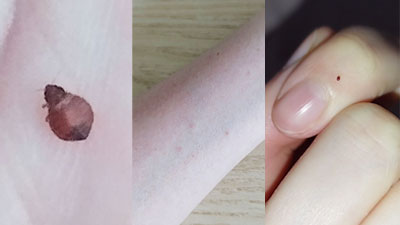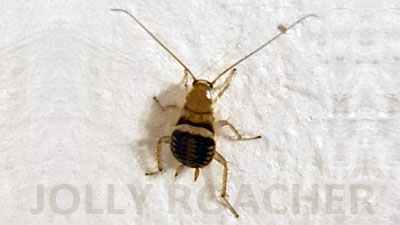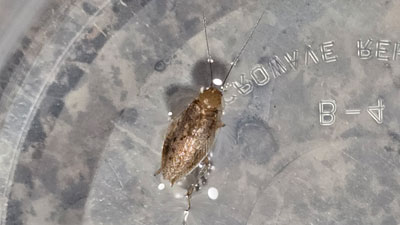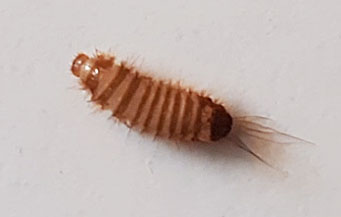These are bed bugs and they bite people. But these bugs are not common bed bugs, they’re special – they do not breed in houses and apartments, but sometimes crawl here from outside. These are swallow bugs in the house of one of my viewers:
In a nutshell: these are swallow bugs Oeciacus hirundinis. They breed in the nests of swallows and other small birds (including starlings, wheatears, and others), and will normally bite them and their chicks. But when the chicks fly out of the nests and there is no food source left for the bedbugs, some of them crawl out of the nests and go to look for either other birds nests or shelter for the winter. And in such wanderings they can penetrate apartments, and here they bite both people and pets.

At the same time, outwardly these bedbugs are practically no different from those that breed en masse in houses and apartments and feed almost exclusively on human blood. The fact is that there are about 100 species in the bed bug family Cimicidae. Of these, only two are permanent, we can say – specialized human parasites. These are the common bed bug Cimex lectularius and its tropical relative Cimex hemipterus.
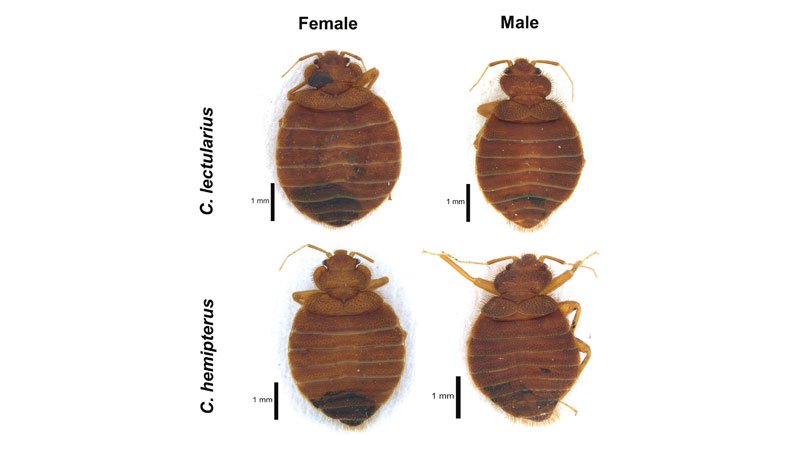
The remaining hundred are species that parasitize other animal species: bats, birds, and others. And most of them can, if necessary, attack hosts that are atypical for them.
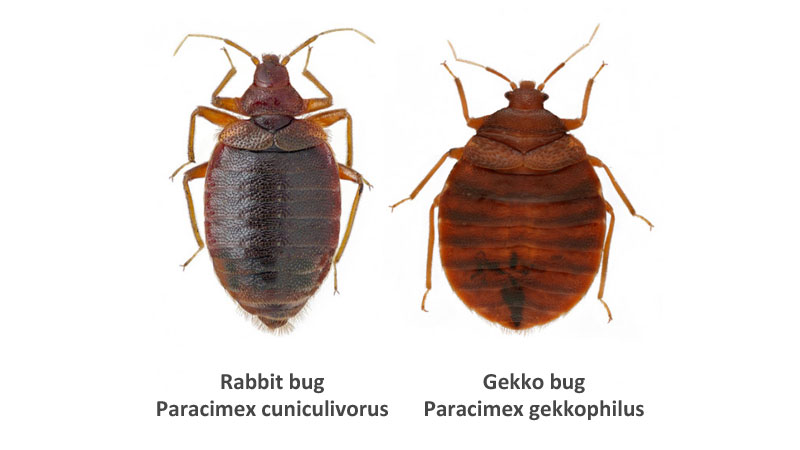
For example, a common bed bug can bite cats, dogs and bats when hungry. Moreover, in the wild, these common bed bugs live in wild caves and feed there precisely on the blood of bats. But those of their brethren that have mastered human homes for living switched specifically to humans.
Similarly, swallow bugs normally feed on the blood of birds, but in extreme situations they can attack other warm-blooded animals, including humans. Here, for example, is documentary photos of the biting swallow bug and consequenses of its bite in the man:

And if such swallow bugs live in a house (for example, in an attic), or on a house (for instance, in martins nest on outer wall), or near a house, then at the onset of unfavorable conditions and the loss of the main feeders they can begin to bite animals and people living in the house.
But there is good news as well: these bugs do not breed where there are no bird nests. That is, even if they end up in an apartment and bite people here, they will not breed and form clusters here. This means that after some time they will disappear even without human effort.
There are no unambiguous statistics, but I have not heard or found information anywhere about swallow bugs in a house biting people for longer than 1-2 weeks in a row. As a rule, all reports about these parasites state the fact that people simply find them near windows, and in some cases discover single bites from these bugs.
In other words, such bugs are unpleasant insects in a house, but they do not pose any serious threat. Therefore, when they are detected, there is no need to take any serious and large-scale measures, which are taken when an apartment is infested with common bed bugs – such as disinfestation of the entire room and revision of all furniture. Swallow bugs are quite easy to kill when finding – just crush them with your fingers. They do not appear in a house in large numbers, and therefore such a fight will be enough to quickly destroy them all, even before they find sleeping people and bite them.
But the main problem here is to understand whether you found a common bed bug, or an “uncommon” swallow bug in the house.
How to differ common bed bugs from swallow bugs in a house?
Common bed bugs and swallow bugs are very difficult to distinguish by external features. Here are the main differences between them:
- Swallow bugs are slightly smaller than common bed bugs. Adult females and males are on average 1-1,5 mm shorter than Cimex lectularius individuals.
- Swallow bugs have slightly denser body hairs.
- The brown body color of swallow bugs is slightly less intense than that of the common bed bugs. They are a little paler.
All these distinctions are very small, they are difficult to see with the naked eye, especially without having individuals of both species at hand at the same time. Agree, if you look at one insect, it is not obvious at all whether it is too hairy or not too hairy.
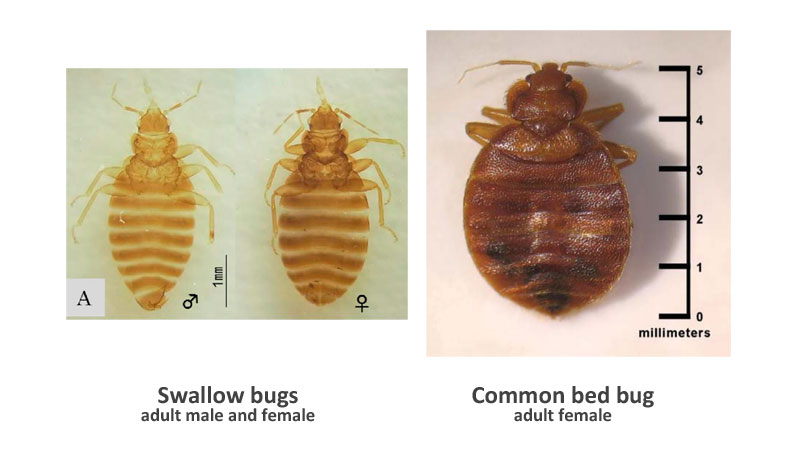
Similarly, with a body size of 4-5 mm, it is not clear whether each particular individual is too small for an ordinary bug, or of a normal size.
Therefore, the only reliable diagnostic feature to distinguish between these species is precisely the observation of these insects near bird nests. Common bed bugs will not regularly climb through windows onto the outside walls of a house and will not crawl near swallow nests there. Even if a single individual moves from one apartment to another for some reason and happens to be near the nest in passing, several bed bugs here is an almost unrealistic situation.
Swallow bugs, on the other hand, do run around here and can naturally end up here, not even alone.
This is exactly how I identified swallow bugs in the house in this video: the insects here are crawling near the nests, on the walls, and on the windows. If the author of the footage had filmed only those individuals that he found at home, then it would be impossible to say with certainty that these were swallow bugs. Exactly the parasites on the outer walls and near the nests indicate that they are Oeciacus hirundinis.
Therefore, if you find bed bugs near the windows, do a little inspection:
- Inspect the bed, mattress and walls near them. If there are clusters of bed bugs, then these are common bed bugs. If there are no swarms, go to the window.
- Inspect the outer walls, window slopes and drains outside the room from the window.
- Look for swallows’ nests near your windows or near your neighbors’ windows.
If you find at least a few bed bugs on the outside wall, and even more so if there is a swallow’s nest somewhere within view, you can be sure that these are swallow bugs and representatives of exactly this species have already gotten into your apartment. Close the windows and seal the drainage holes in the frames with tape so that new parasites do not get into the room. And simply crush those that have already climbed into the room.
Note
Mosquito net does not keep bedbugs out. They easily crawl both between its frame and the window frame, and through the drainage holes, which such a mesh often does not cover.
If there is already a cluster of bed bugs on the sleeping place, it means that these are common bed bugs, and they need to be exterminated using completely different, more complex methods.
And if even after this you couldn’t recognize the insects at home, feel free to send me photos and videos of them. I will definitely read your letter, look at your footage and try to tell you what you were lucky enough to encounter.
And in case this post helps you and you want to thank me, then you can send me a donation in any convenient way. This support will help me publish even more photos and videos of our tiny housemates.

